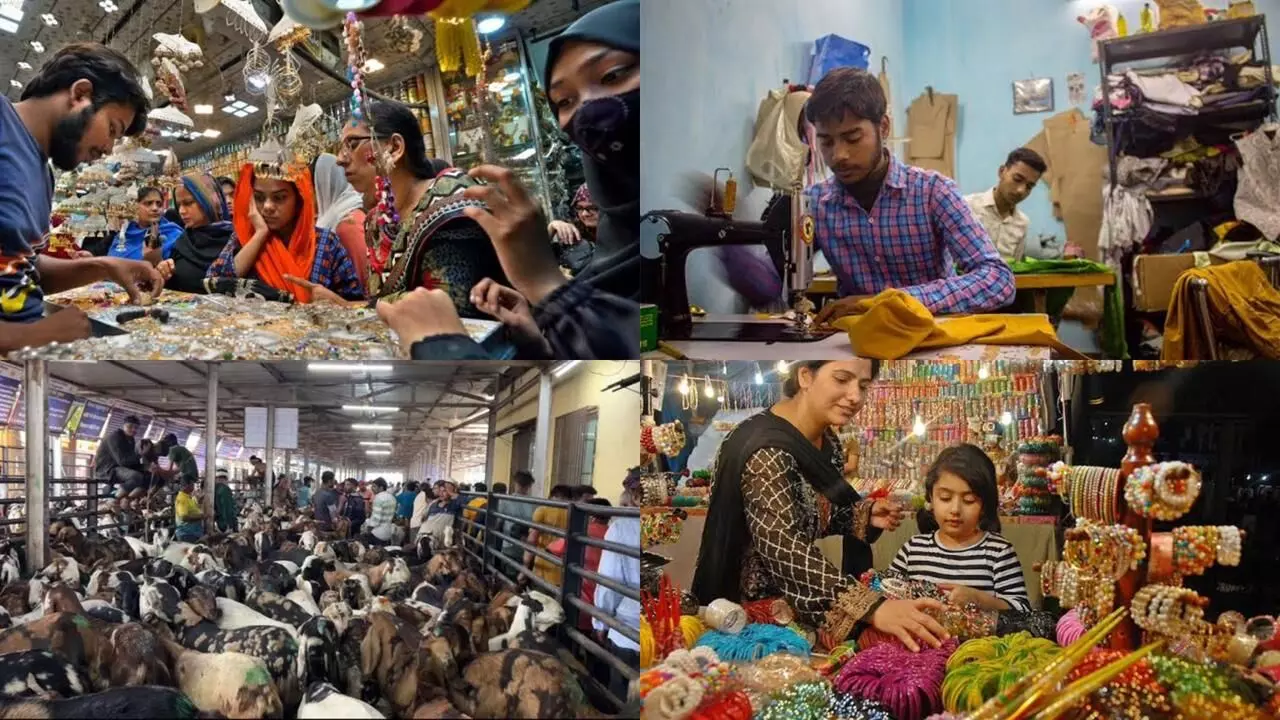Eid economy: How traders, vendors, and tailors treat it like year-end season
Digital platforms are also carving a niche in the Eid economy
By Anoushka Caroline Williams
How traders, vendors, and tailors treat it like year-end season for Eid
Hyderabad: Eid al-Adha, also known as Bakr Eid, is one of the most significant Islamic festivals in the world. In India, where nearly 200 million Muslims observe the occasion, the festival brings not only spiritual reflection but also a surge in economic activity.
From livestock traders to food vendors, tailors to transporters, the festival sustains seasonal livelihoods for thousands. For many, this three-day celebration is the financial equivalent of a fiscal year-end.
Mohammed Azim, an economist who studies informal markets at the Centre for Livelihood Studies in Hyderabad, explains, “Bakr Eid is not just a religious event — it’s a rural-to-urban supply chain. It impacts agriculture, logistics, animal health services, and even e-commerce.”
The Lifeline of Livestock Mandis
In cities like Hyderabad, Kolkata, Lucknow, and Bhopal, temporary goat and cattle markets (mandis) swell with activity weeks before Eid. Farmers and livestock traders travel from interior villages, often investing in fodder, vaccines, and transportation over months to rear sacrificial animals.
At Hyderabad’s Mehdipatnam mandi, transactions can run into crores in just a fortnight. Baseer Ali, a goat farmer from Mahbubnagar, says, “The sale I make during Eid can cover my family’s needs for the next five months. If I don’t get a good price, it hits us hard.”
These mandis create short-term employment too — for brokers, cleaners, loaders, and tea vendors. The ripple effect continues as families purchase animals, food, garments, and gifts, triggering a mini consumption cycle.
Tailors, Textile Sellers, and the Eid Rush
Fashion is another major economic segment that sees a boom. Tailors, boutique owners, and readymade garment sellers in cities like Hyderabad, Mumbai, and Delhi report peak workloads ahead of Eid.
“We do 40% of our annual tailoring business in just the 20 days before Bakr Eid,” says Abrar Jaleel, who runs a tailoring shop in Hyderabad’s Tolichowki area. “Men want kurtas, children want matching sets, and women look for new abayas or saris. Even with rising costs, people prioritise looking their best.”
Textile markets in Charminar, Chandni Chowk, and Bhendi Bazaar become packed with last-minute shoppers, supporting not just formal retail but also small-scale artisans, dyers, embroiderers, and street hawkers.
The Food Chain: From Butchers to Biryani
For butchers and meat processors, Bakr Eid is one of the busiest periods. Salman Ali, a licensed butcher in Old City Hyderabad, says, “We prepare weeks in advance. There are health checks, transport coordination, and a huge demand. But we also face stricter scrutiny now due to civic regulations.”
Following the sacrifice, the distribution of meat — a religious obligation — supports the informal courier system, dry ice suppliers, and packaging providers. Simultaneously, a surge in cooking — especially of dishes like haleem, biryani, and sheer khurma — boosts demand for dairy, dry fruits, rice, and spices.
Even restaurants and catering services see higher orders. Savita Batra, a cloud kitchen owner in Hyderabad catering to mixed clientele, says, “Many working families now prefer ordering festive meals instead of cooking at home. It’s a great opportunity for small culinary businesses.”
E-Commerce, Online Qurbani, and the Digital Turn
Digital platforms are also carving a niche in the Eid economy. From goat delivery apps to eidi wallets, the younger generation is reshaping how traditions are practiced.
This shift has also enabled gig workers — delivery agents, call center workers, and content creators — to benefit from the digital economy’s spillover.
A Festival with a Multiplier Effect
While hard data is limited due to the largely informal nature of these transactions, economists estimate that Bakr Eid contributes thousands of crores to India’s micro and small-scale economy annually.
The multiplier effect goes beyond religion. From Hindu farmhands assisting in goat transport to Sikh logistics operators and Christian garment workers, the festival showcases the interdependence of seasonal economies in India.
Looking Ahead: Between Profit and Pressure
While the economic benefits are significant, the festival also brings challenges — price fluctuations, exploitation of traders, civic restrictions, and concerns over animal welfare. With increasing urban regulations and political scrutiny, several stakeholders feel caught between tradition and compliance.
Still, the resilience of those who depend on this season year after year remains unshaken.